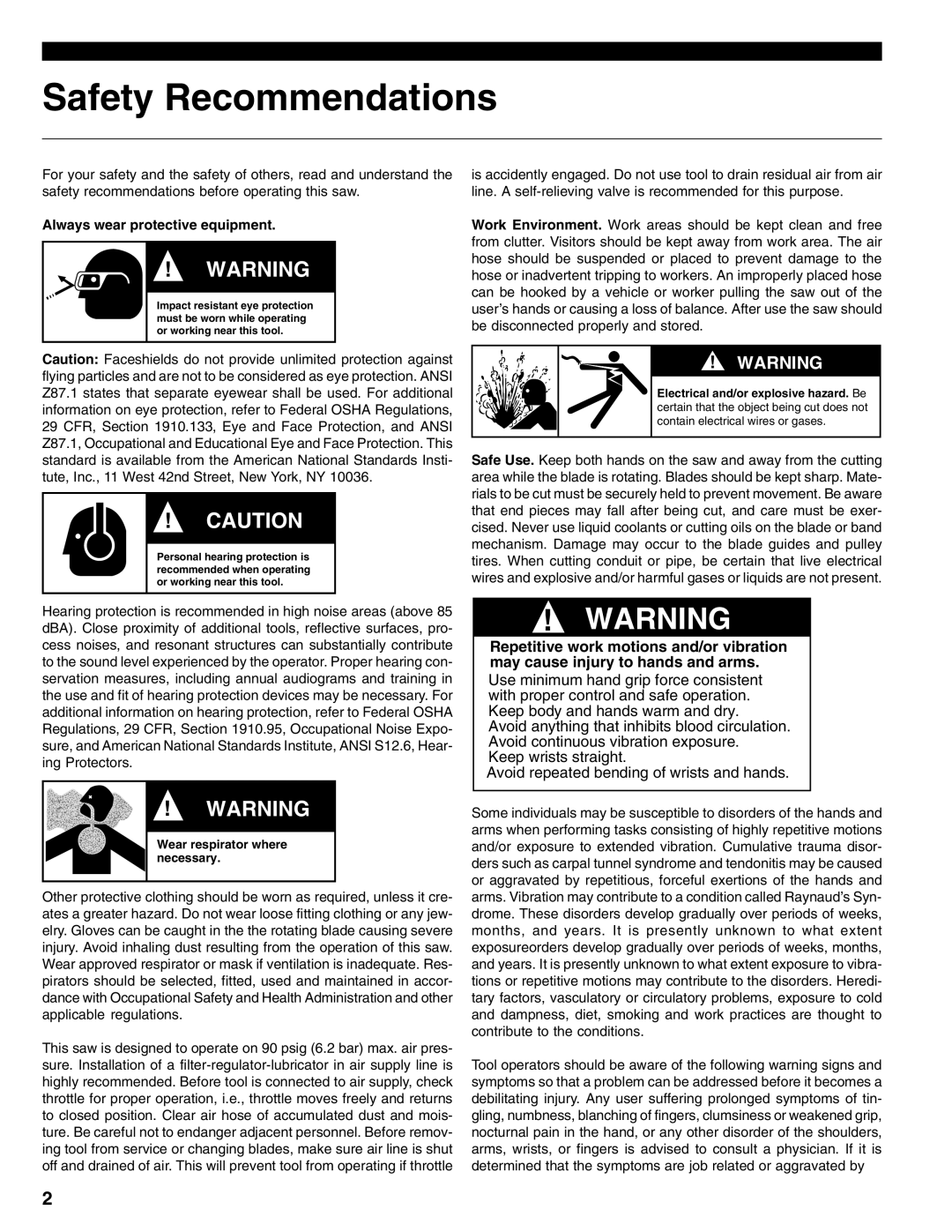
Safety Recommendations
For your safety and the safety of others, read and understand the safety recommendations before operating this saw.
Always wear protective equipment.
!WARNING
Impact resistant eye protection must be worn while operating or working near this tool.
Caution: Faceshields do not provide unlimited protection against flying particles and are not to be considered as eye protection. ANSI Z87.1 states that separate eyewear shall be used. For additional information on eye protection, refer to Federal OSHA Regulations, 29 CFR, Section 1910.133, Eye and Face Protection, and ANSI Z87.1, Occupational and Educational Eye and Face Protection. This standard is available from the American National Standards Insti- tute, Inc., 11 West 42nd Street, New York, NY 10036.
! CAUTION
Personal hearing protection is recommended when operating or working near this tool.
Hearing protection is recommended in high noise areas (above 85 dBA). Close proximity of additional tools, reflective surfaces, pro- cess noises, and resonant structures can substantially contribute to the sound level experienced by the operator. Proper hearing con- servation measures, including annual audiograms and training in the use and fit of hearing protection devices may be necessary. For additional information on hearing protection, refer to Federal OSHA Regulations, 29 CFR, Section 1910.95, Occupational Noise Expo- sure, and American National Standards Institute, ANSI S12.6, Hear- ing Protectors.
! WARNING
Wear respirator where necessary.
Other protective clothing should be worn as required, unless it cre- ates a greater hazard. Do not wear loose fitting clothing or any jew- elry. Gloves can be caught in the the rotating blade causing severe injury. Avoid inhaling dust resulting from the operation of this saw. Wear approved respirator or mask if ventilation is inadequate. Res- pirators should be selected, fitted, used and maintained in accor- dance with Occupational Safety and Health Administration and other applicable regulations.
This saw is designed to operate on 90 psig (6.2 bar) max. air pres- sure. Installation of a
is accidently engaged. Do not use tool to drain residual air from air line. A
Work Environment. Work areas should be kept clean and free from clutter. Visitors should be kept away from work area. The air hose should be suspended or placed to prevent damage to the hose or inadvertent tripping to workers. An improperly placed hose can be hooked by a vehicle or worker pulling the saw out of the user’s hands or causing a loss of balance. After use the saw should be disconnected properly and stored.
! WARNING
Electrical and/or explosive hazard. Be certain that the object being cut does not contain electrical wires or gases.
Safe Use. Keep both hands on the saw and away from the cutting area while the blade is rotating. Blades should be kept sharp. Mate- rials to be cut must be securely held to prevent movement. Be aware that end pieces may fall after being cut, and care must be exer- cised. Never use liquid coolants or cutting oils on the blade or band mechanism. Damage may occur to the blade guides and pulley tires. When cutting conduit or pipe, be certain that live electrical wires and explosive and/or harmful gases or liquids are not present.
!WARNING
Repetitive work motions and/or vibration may cause injury to hands and arms.
Use minimum hand grip force consistent with proper control and safe operation. Keep body and hands warm and dry.
Avoid anything that inhibits blood circulation. Avoid continuous vibration exposure.
Keep wrists straight.
Avoid repeated bending of wrists and hands.
Some individuals may be susceptible to disorders of the hands and arms when performing tasks consisting of highly repetitive motions and/or exposure to extended vibration. Cumulative trauma disor- ders such as carpal tunnel syndrome and tendonitis may be caused or aggravated by repetitious, forceful exertions of the hands and arms. Vibration may contribute to a condition called Raynaud’s Syn- drome. These disorders develop gradually over periods of weeks, months, and years. It is presently unknown to what extent exposureorders develop gradually over periods of weeks, months, and years. It is presently unknown to what extent exposure to vibra- tions or repetitive motions may contribute to the disorders. Heredi- tary factors, vasculatory or circulatory problems, exposure to cold and dampness, diet, smoking and work practices are thought to contribute to the conditions.
Tool operators should be aware of the following warning signs and symptoms so that a problem can be addressed before it becomes a debilitating injury. Any user suffering prolonged symptoms of tin- gling, numbness, blanching of fingers, clumsiness or weakened grip, nocturnal pain in the hand, or any other disorder of the shoulders, arms, wrists, or fingers is advised to consult a physician. If it is determined that the symptoms are job related or aggravated by
2
